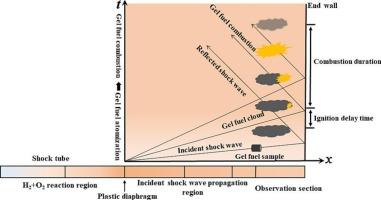A comparative study on the atomization and combustion behaviors of gel fuel containing spherical and flake aluminum particles under shock wave loading
IF 7.5
1区 工程技术
Q2 ENERGY & FUELS
引用次数: 0
Abstract
Metallized gel fuels have emerged as a promising solution to meet the urgent demand for higher performance fuels in advanced aerospace vehicles, due to their significant improvement in the main combustion performance and safety characteristics compared with conventional liquid fuels. In this study, a comparative investigation of the atomization, ignition, and combustion behaviors of gel fuels containing spherical and flake aluminum particles was performed under shock wave loading. A high-speed video camera was employed to observe the dynamic behaviors of these gel fuels under the effect of shock wave, while pressure was measured by the pressure transducers. The results showed that the gel fuel containing spherical aluminum particles exhibited easier atomization under the effects of shock wave than gel fuel containing flake aluminum particles. Identical critical shock wave intensity for igniting the gel fuels containing spherical and flake aluminum particles was observed, measured at Ma 3.06. The ignition delay time of both gel fuels decreased with shock intensity increasing, but the ignition delay time of gel fuel containing flake aluminum particles showed a more significant pressure-dependent behavior. Compared with gel fuel with flake aluminum particles, the combustion duration of gel fuel containing spherical aluminum particles was generally longer and exhibited a stronger dependence on the shock wave intensity. This study offers new insights into the atomization behaviors and combustion mechanism of aluminum-containing gel fuel, and the findings can serve as a valuable reference for the design and practical application of gel fuel.

含球形和片状铝颗粒凝胶燃料在激波载荷下雾化和燃烧行为的对比研究
与传统液体燃料相比,金属化凝胶燃料在主要燃烧性能和安全特性方面有了显著改善,成为满足先进航天飞行器对高性能燃料迫切需求的一种有前景的解决方案。在本研究中,对含球形和片状铝颗粒的凝胶燃料在激波载荷下的雾化、点火和燃烧行为进行了对比研究。利用高速摄像机观察了这些凝胶燃料在激波作用下的动力学行为,并通过压力传感器测量了压力。结果表明,含球形铝颗粒的凝胶燃料在激波作用下比含片状铝颗粒的凝胶燃料更容易雾化。观察到含有球形和片状铝颗粒的凝胶燃料的临界激波强度相同,测量值为3.06 Ma。两种凝胶燃料的点火延迟时间均随冲击强度的增加而减小,但含片状铝颗粒的凝胶燃料的点火延迟时间表现出更显著的压力依赖性。与片状铝颗粒凝胶燃料相比,球形铝颗粒凝胶燃料的燃烧持续时间普遍更长,且对激波强度的依赖性更强。本研究对含铝凝胶燃料的雾化行为和燃烧机理有了新的认识,研究结果可为凝胶燃料的设计和实际应用提供有价值的参考。
本文章由计算机程序翻译,如有差异,请以英文原文为准。
求助全文
约1分钟内获得全文
求助全文
来源期刊

Fuel
工程技术-工程:化工
CiteScore
12.80
自引率
20.30%
发文量
3506
审稿时长
64 days
期刊介绍:
The exploration of energy sources remains a critical matter of study. For the past nine decades, fuel has consistently held the forefront in primary research efforts within the field of energy science. This area of investigation encompasses a wide range of subjects, with a particular emphasis on emerging concerns like environmental factors and pollution.
 求助内容:
求助内容: 应助结果提醒方式:
应助结果提醒方式:


